|
Robotics
by
Dr. Rob van der Bijl, Amsterdam, Netherlands
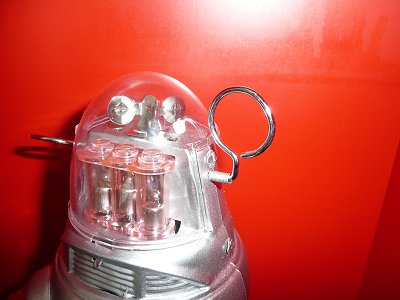
May 2008, RVDB
Urban Planning launched a 'playful' research into robotics. Inspired
by Isaac Asimov with his famous Sci-Fi novel 'I Robot'. Our research
has mainly focused on the possibilities of humanoid robots. In the
years that followed, a lot of inspiration was gained in Japan, where
this type of robot was considered to have great future value.
Nevertheless,
we eventually had to conclude that mature applications within the
axiom of the 'humanoid robot' are actually hardly possible. In
fact, it turns out to be a naive, not to say childish idea that the
analogy
with the human body would form a sound basis for practical and
professional applications of robotics.
For successful applications,
we should
rather think of clearly defined environments, such as in many industries,
in which robot machines perform strict tasks.
Our research
(the period May 2008 – December 2022 so far) is summarized
on this page in three parts. Backgrounds and our own experiences
with the idea of a humanoid robot fill the first part. With the
remaining two parts we will discuss what we think can be done with
that idea,
namely making art and toys. Some examples of applications in the
field of art are included in part 2. Finally, in the third part,
we look at what we what we ultimately want to do: playing robots.
But first, here's a brief overview of our experience with artificial
intelligence.
 
Backgrounds
The Robotics Project is rooted in our previous research to knowledge based
systems (1988-1998) that was partially funded by the Dutch Foundation for
Applied Technical Science (STW). This research project was finalized as
a PhD in June 1998 (University of Technology, Delft, Netherlands). See Repository TU-Delft.
RVDB applied knowledge based principles in several assignments and related
projects (1998-2008). Predore - Precedent Documentation & Registration
- represents a major enterprise in this field. See Predore
at RVDB Urban Planning.
Part 1 - HUMANOIDS
Our classic
reference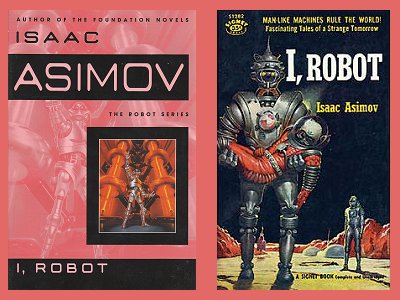
Cover of I, Robot (left) and cover of the 1950 original (right).
 In
the future of Isaac Asimov car parking wouldn't resemble anything
from nowadays automatic parking systems such as developed by Toyota
Motor Corporation. In stead they would look like classic 1950s American
car parks, however served by human-like Robot-Attendants. Moreover,
in the world of Asimov the ambiguity of natural language would causes
fundamental misunderstandings between humans and robots. In
the future of Isaac Asimov car parking wouldn't resemble anything
from nowadays automatic parking systems such as developed by Toyota
Motor Corporation. In stead they would look like classic 1950s American
car parks, however served by human-like Robot-Attendants. Moreover,
in the world of Asimov the ambiguity of natural language would causes
fundamental misunderstandings between humans and robots.
In the anthology I, Robot (1950) Asimov published comprehensively his
'Three Laws of Robotics'. One: a robot may not injure a human being or, through
inaction, allow a human being to come to harm. Two: a robot must obey the orders
given to it by human beings, except where such orders would conflict with the
First Law. Three: a robot must protect its own existence as long as such protection
does not conflict with the First or Second Laws.
Whatever the quality of their 'positronic' brains may have be, in real future
life Asimov's robots would be incapable to act. The laws would be simply rule-out
their ability to act according given commands due to contradictions between
the laws itself. And moreover due to contextual constrains not taken into account
by the very same laws. Still we do love the work of 'robot pioneer' Asimov.
We have read the Bantam reprint of I Robot (May 2008) with great pleasure.
Particularly we liked the struggle of both humans and robots so as to meet
the requirements of the three laws. Our latest re-reading: December 2022!
Japan revisited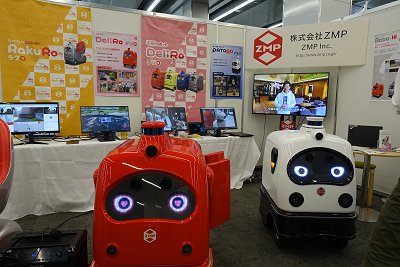
ZMP and some of their 'Robots of Everything' -
photo by Rob van der Bijl, Tokyo, May 19, 2022.
 May
2022: During a visit to a fair in Tokyo, we met the company ZMP and
their 'Robots of Everything'. Indeed, less humanoid, but the eyes
of the robot cars still try to endear us. Meanwhile in Japan, work
on human robots continues persistently. See
this overview by the Wall Street Journal. May
2022: During a visit to a fair in Tokyo, we met the company ZMP and
their 'Robots of Everything'. Indeed, less humanoid, but the eyes
of the robot cars still try to endear us. Meanwhile in Japan, work
on human robots continues persistently. See
this overview by the Wall Street Journal.
Confusion in
Japan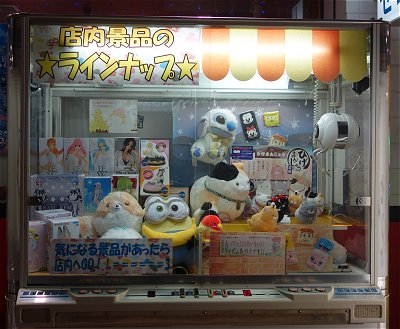
Lined up, in store prizes machine -
photo by Rob van der Bijl, Tokyo, October 13, 2018.
 October
2018: In Japan it is often not easy to distinguish between humans
and animals, or between dolls and robots, or between humanoids and
animaloids. Even the grabber is creating confusion. Is this a simple
device or a hanging robot, or robot crane? Our investigation continues … October
2018: In Japan it is often not easy to distinguish between humans
and animals, or between dolls and robots, or between humanoids and
animaloids. Even the grabber is creating confusion. Is this a simple
device or a hanging robot, or robot crane? Our investigation continues …
This is not
a robot
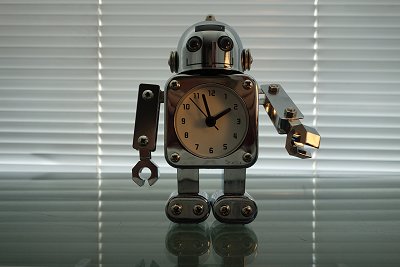
Le robot qui ne rêvait pas… - photo by Rob van der Bijl,
September 6, 2014.
 September
2014: This is not a robot. It’s a simple, toy-like table-top
object. Still it mirrors robot culture, it alludes to our techno-oriented
culture, full of believes in engaged robotics and blessed technology.
Will robots ever dream? A valid question or not. Will this clock-robot
ever dream of electric sheep, or hairy cats? Watch
our video from the French department of our Robotics Lab. September
2014: This is not a robot. It’s a simple, toy-like table-top
object. Still it mirrors robot culture, it alludes to our techno-oriented
culture, full of believes in engaged robotics and blessed technology.
Will robots ever dream? A valid question or not. Will this clock-robot
ever dream of electric sheep, or hairy cats? Watch
our video from the French department of our Robotics Lab.
Japanese Robots
have a Soul!
Geminoid F at a concert (Photo courtesy: Watasi Nana).
 February
2013: Famous Japanese 'Robo Prof' Hiroshi Ishiguro attempts
to mimic shape, expression, motion, and behavior of human beings.
His robots have a 'soul'. They act as closely as possible to human
beings. February
2013: Famous Japanese 'Robo Prof' Hiroshi Ishiguro attempts
to mimic shape, expression, motion, and behavior of human beings.
His robots have a 'soul'. They act as closely as possible to human
beings.
Japanese robots, including virtual computer
girls, possess a spirit. Japanese animism and particularly Shinto-oriented
'conceptual systems', back the believe that robots and objects are
more than just things. Geminoid-F of Hiroshi Ishiguro proves that the
border between robots and people is not very sharp in Japan. Watch
his video at Vimeo, 'Everything has a soul'.
At Robosquare,
Fukuoka, Japan
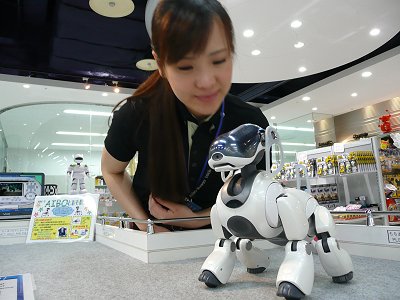
AIBO at Robosquare, Fukuoka, Japan - photo by Rob van
der Bijl, April 16, 2010.
 April
2010: RVDB was received in the intimate exhibition space of Robosquare,
Fukuoka, Japan. And introduced to AIBO, the robotic pet of Sony,
still performing here, though production ceased in 2006. However,
again introduced when the fourth generation model was launched in
2018. And yes, still we do love the mass-marketed AIBO. See
our little movie 'Aibo Dancing' made at Robosquare. April
2010: RVDB was received in the intimate exhibition space of Robosquare,
Fukuoka, Japan. And introduced to AIBO, the robotic pet of Sony,
still performing here, though production ceased in 2006. However,
again introduced when the fourth generation model was launched in
2018. And yes, still we do love the mass-marketed AIBO. See
our little movie 'Aibo Dancing' made at Robosquare.
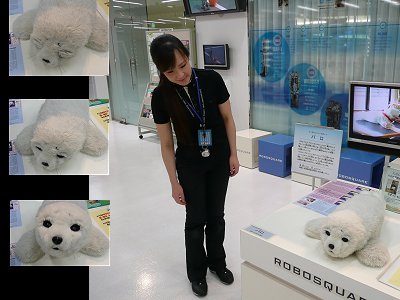
PARO at Robosquare, Fukuoka, Japan - photos by Rob van
der Bijl, April 16, 2010.
 PARO
is a Mental Commitment Robot, shaped as a seal. Unlike industrial
robots, "Mental Commitment Robots" are developed to interact
with human beings and to make them feel emotional attached to the
robots. These robots trigger more subjective considerations, evoking
mental impressions such as 'cuteness'. PARO
is a Mental Commitment Robot, shaped as a seal. Unlike industrial
robots, "Mental Commitment Robots" are developed to interact
with human beings and to make them feel emotional attached to the
robots. These robots trigger more subjective considerations, evoking
mental impressions such as 'cuteness'.

Footage from PARO promotion video at Robosquare,
Fukuoka, Japan - compillation by Rob van der Bijl, April 16, 2010.
Mixed
feelings certainly. The video (see footage) proves more or less the
effectiveness of PARO, but we're still not sure if this "Mental
Commitment Robot" represents the ultimate solution. The human-machine
relation is perhaps too artificial or at least very mechanical and
poor.
Part
2 - ART
Robot Ladies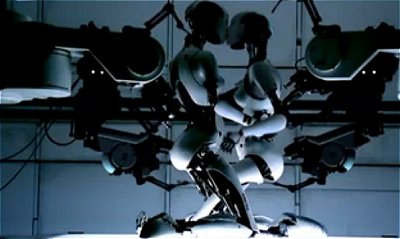
Footage from the video at YouTube.
 "All
Is Full of Love" is a song by Björk, from her album
Homogenic. The video is a nice example of entertainment which alludes
to the existence of human like robots - robot ladies actually as
the
video at YouTube proves. "All
Is Full of Love" is a song by Björk, from her album
Homogenic. The video is a nice example of entertainment which alludes
to the existence of human like robots - robot ladies actually as
the
video at YouTube proves.
Brain
Mock
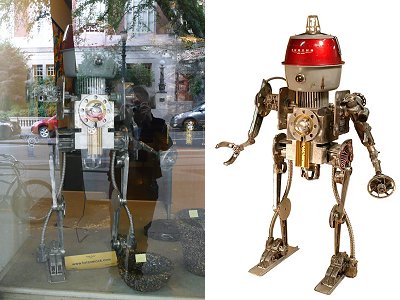
Left: Eureka Robot in the shop window -
photo by Rob van der Bijl, Portland (Oregon. US) August 7,
2009. Right: at the website of Brain Mock.
 Years
ago Brian Mock explained that he was ‘intrigued by the challenge
of creating something unique, fun, and inherently curious’.
We particularly were impressed by his robot figure (the Eureka Robot)
which we encountered by coincidence during a walk in the city of
Portland,
Oregon (US).
Brain applies unusual found objects and everyday items into his sculptures.
Meanwhile his work has developed impressively – please, visit
his website full of ‘fine art created from 100% reclaimed materials’. Years
ago Brian Mock explained that he was ‘intrigued by the challenge
of creating something unique, fun, and inherently curious’.
We particularly were impressed by his robot figure (the Eureka Robot)
which we encountered by coincidence during a walk in the city of
Portland,
Oregon (US).
Brain applies unusual found objects and everyday items into his sculptures.
Meanwhile his work has developed impressively – please, visit
his website full of ‘fine art created from 100% reclaimed materials’.
Brianmock.com
RoboThespian
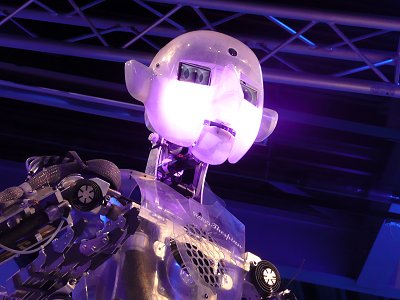
Robothespian™ at
Industrion, Kerkrade, Netherlands - photo by Rob van der Bijl, February
20, 2009.
 RoboThespian™ is
a life-sized humanoid exhibition exhibit, a robot actor whose primary
function is theatrical performance. RoboThespian™ was created
to educate, communicate, interact and entertain. See
more at Engineered
Arts. RoboThespian™ is
a life-sized humanoid exhibition exhibit, a robot actor whose primary
function is theatrical performance. RoboThespian™ was created
to educate, communicate, interact and entertain. See
more at Engineered
Arts.
Strandbeest
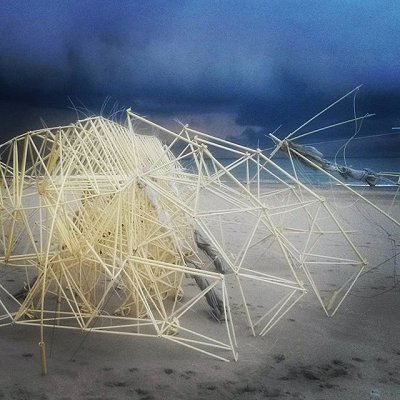 Strandbeest model
- photo by Rob van der Bijl, The Hague, September 21, 2015. Strandbeest model
- photo by Rob van der Bijl, The Hague, September 21, 2015.
 Many
times we encountered the artist Theo Jansen and his 'Strandbeests'
at the beach of The Hague (Netherlands). Theo is a Dutch artist who
builds
a kind
of wind propelled robots that he calls "a new form of live".
Although strictly speaking not humanoids, Theo Jansen's beasts certainly resemble
animaloids. Many
times we encountered the artist Theo Jansen and his 'Strandbeests'
at the beach of The Hague (Netherlands). Theo is a Dutch artist who
builds
a kind
of wind propelled robots that he calls "a new form of live".
Although strictly speaking not humanoids, Theo Jansen's beasts certainly resemble
animaloids.
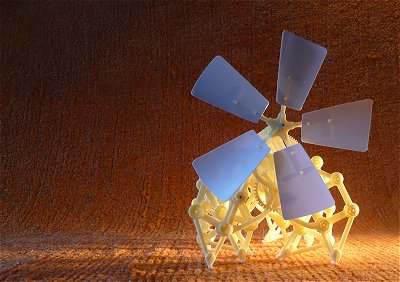 Strandbeest model
on Orange Beach - photo by Rob van der Bijl, October 9, 2011. Strandbeest model
on Orange Beach - photo by Rob van der Bijl, October 9, 2011.
We
tested a miniature version of 'Animaris Ordis Parvus' on Orange Beach
at our Robotics
Lab. Watch
our video. More information at the site of Theo Jansen, strandbeest.com.
Robodock
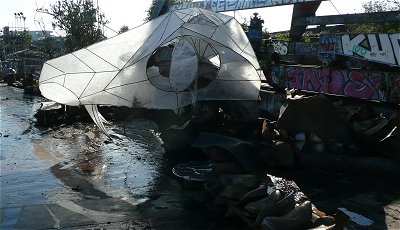
Robodock
Fragment of a model during the day after, Amsterdam, Netherlands- photo
by Rob van der Bijl, September 26, 2010.
 Robodock (1998-2012) was the pre-eminent art and technology
festival of the Netherlands, with its awe-inspiring kinetic sculptures,
pyro-installations,
absurdist acts, robots, live-music and DJ’s.
Robodock (1998-2012) was the pre-eminent art and technology
festival of the Netherlands, with its awe-inspiring kinetic sculptures,
pyro-installations,
absurdist acts, robots, live-music and DJ’s.

Robodock
The 'Egg' construction, part of The Fenix project, during the day after,
Amsterdam, Netherlands - photo by Rob van der Bijl, September 26, 2010.
The
Fenix at Robodock 2010 was highlight of an event full of overwhelming
mechanical sculptures,
magical sounds and robots.
The Fenix, designed by 2012Architects, Césare Peeren & Arie
van Ziel - Construction: Robodock team, Ruud Panhuizen & Bart Sabel.
Part
3 - Toys
Vintage toys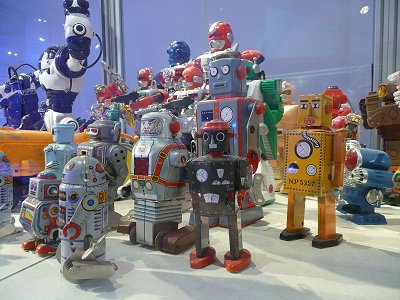
Collection of toy robots at
Industrion, Kerkrade, Netherlands - photo by Rob van der Bijl, February
20, 2009.
 There
are many collections around the world. Like the one we checked at
Industrion. More
on this
subject at the
Osaka Tin Toy Institute. There
are many collections around the world. Like the one we checked at
Industrion. More
on this
subject at the
Osaka Tin Toy Institute.
Sex toys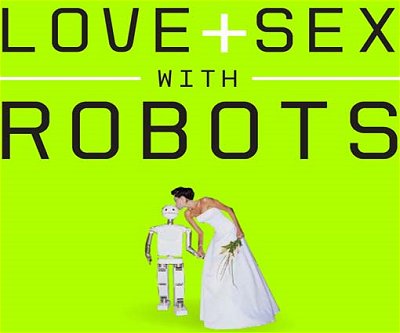
Book cover
 We
enjoyed reading this book about sex robots that push the potentially
humanoid nature of robots to the limit. Perhaps Levy is right that
eventually (he once mentioned the year 2050) these types of sex toys
will have become routinely accepted by the public. That does not
alter the fact that it can still be problematic to view prostitution
as a case model of sexual relationships. We
enjoyed reading this book about sex robots that push the potentially
humanoid nature of robots to the limit. Perhaps Levy is right that
eventually (he once mentioned the year 2050) these types of sex toys
will have become routinely accepted by the public. That does not
alter the fact that it can still be problematic to view prostitution
as a case model of sexual relationships.
Some
of our references:
David Levy; Love
and Sex with Robots: The Evolution of Human-Robot Relationships.
HarperCollins Publishers, 2007.
Or the PhD-version:
Intimate Relationships with Artificial Partners. Maastricht University
(Netherlands), October 2007.
Peter Menzel & Faith D'Aluisio; Robo Sapiens: Evolution of a New Species.
MIT Press, 2000.
Ian Yeoman, Michelle Mars; Robots, men and sex tourism. In: Futures,
Volume 44, Issue 4, May 2012, Pages 365-371.
Lambèr Royakkers,
Floortje Daemen & Rinie van Est; Overal robots: automatisering
van de liefde tot de dood. Boom/Lemma, 2012.
More tin robot
toys
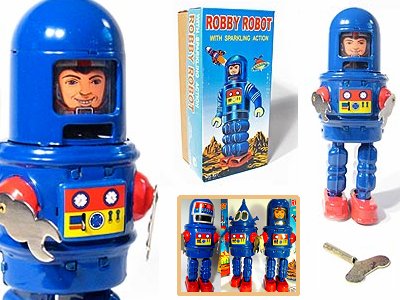 Image
Yonezawa compilation by Rob van der Bijl. Image
Yonezawa compilation by Rob van der Bijl.
 We like the vintage tin robot toys, for instance the Robby
from Yonezawa. Is this robot a man or a
machine? Dome Head Robby
Robot
is a reproduction
of the famous Japanese original (like our Robby we used in the experiments
presented below). With his cute
human face and sparking neck he appears to be having a good day
on an alien
planet. We love to wind him up and then like watching his sparkling
lights and sounds as he moves his feet and walks ahead. He has
an on/off
switch at his red and yellow front panel. His two brothers Cone Head
and Dome Head share the same body and silver wrench-arms.
We like the vintage tin robot toys, for instance the Robby
from Yonezawa. Is this robot a man or a
machine? Dome Head Robby
Robot
is a reproduction
of the famous Japanese original (like our Robby we used in the experiments
presented below). With his cute
human face and sparking neck he appears to be having a good day
on an alien
planet. We love to wind him up and then like watching his sparkling
lights and sounds as he moves his feet and walks ahead. He has
an on/off
switch at his red and yellow front panel. His two brothers Cone Head
and Dome Head share the same body and silver wrench-arms.
Our Robby Project All
Robby photos by Rob van der Bijl. All
Robby photos by Rob van der Bijl.
 May
2008 RVDB launched the ROBBY Project which served as the prologue
of our investigation into the use of humanoid robots. May
2008 RVDB launched the ROBBY Project which served as the prologue
of our investigation into the use of humanoid robots.
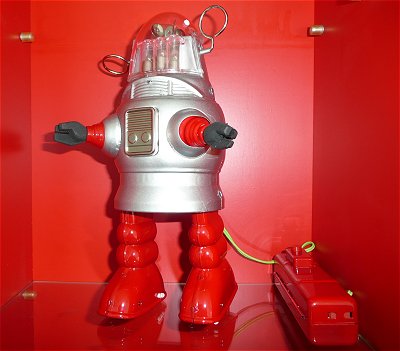
ROBBY's Data - Weight: 0,325 kilo - Length: 214 mm - Average
diameter of torso: 70 mm - Applied materials: metals and plastics -
Propulsion: 3 volt electric motor - Average speed: 51 cm/sec
ROBBY is the name of a Japanese designed toy-bot. Our replica vintage
model (bought at FAO Schwarz, 5th Avenue New York) is in exact scale
to the original Piston Action Robot produced in the 1950's by Nomura
in Japan. A wired remote control enables the robot to walk with bouncing
lighted pistons behind its dome. RVDB subjected the robot to several
experiments and loved the human form analogy which clearly resembles
a still existing believe that real robots should behave and look like
human beings. Though this isn't necessarily true, the idea that a robot
should incorporate human characteristics is still widespread and in
Japan the ground of a very successful robot industry and practice.
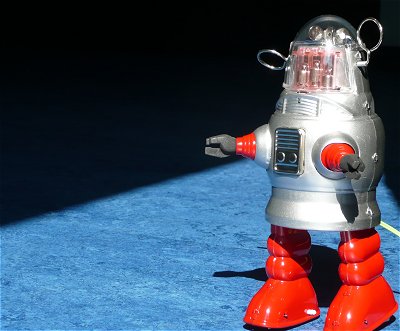
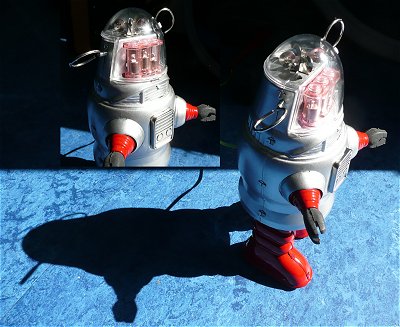
'Burned
by the Sun'
was our very first experiment, exposing ROBBY to natural sunlight. Due
to this light the robot's forms and articulations were brightly visualized.
We still love this experiment that offered us fun and moreover the insight
that the human form analogy is powerful and expressive.
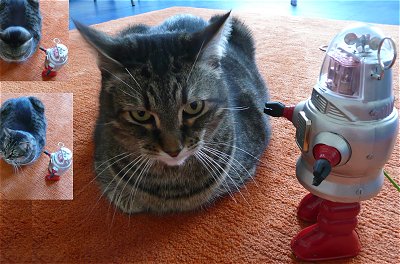
'Encountering Ricky' confronted ROBBY with
an animal. This second experiment briefly addressed the robot-animal
relation, as ROBBY was situated as close as possible to our cat Ricky
(the brother of our other cat Rocky). Ricky didn't seem to have any
problem with the robot. After having activated ROBBY the cat showed
no emotion and the cat turned its head while ROBBY was waiting.
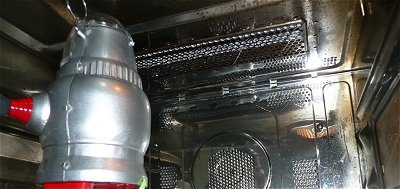
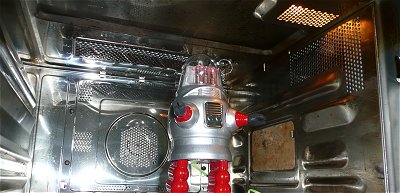
In our third experiment 'Reflected & Rayed'
ROBBY was placed in a microwave oven. First we studied the interior's
reflections while ROBBY was being rotated. Then we decided not to switch
on the microwave utility as we feared that ROBBY would be rayed and
roasted. Sometimes an experiment has to be halted at a premature moment.
Non-applied technical science isn't always easy.
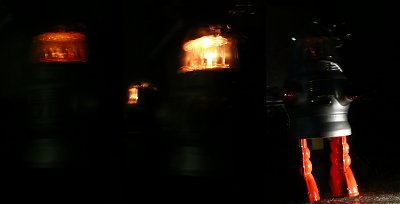
ROBBY's bouncing lighted pistons represent obvious dynamic characteristics
of the robot. In 'Exploring Dungeons',
our fourth experiment ROBBY was walking in the dark, while we were closely
monitoring the visual patterns of the moving lights in its dome. We
didn't analysed the pattern of ROBBY's beaming light, however we feel
that our monitoring activities exposed a basic feature of toy-bots like
ROBBY, that is its shining and attractive appearance due to the interaction
of the light facility and the robot's metal skin.
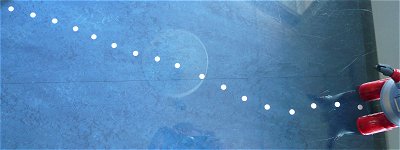
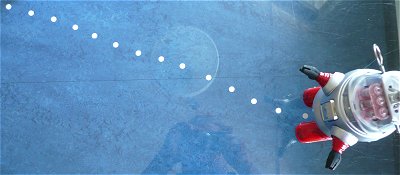

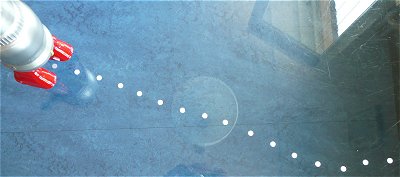
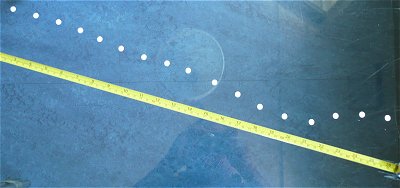
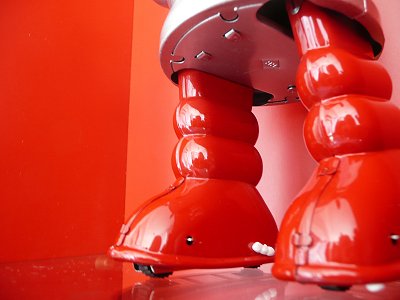
Then the fifth and
final experiment 'Walking Ways' that was
subjected to measurements and analysis of ROBBY's basic quality, namely
the ability to walk. A set of small wheels in the bottom side of each
of ROBBY's feet allows the robot to walk. When the rotation of the axe
within the on board electric motor is mechanically transferred to the
'joints' of both legs it really happens. Yes! ROBBY is walking. As his
legs are moving forwards and backwards the wheels in both feeds start
rolling and ROBBY is walking, and not riding as sometimes has been suggested.
The walking capabilities are primarily linked to the movement of the
propulsed legs and not the wheels as such.
We let ROBBY walking freely while marking his path. The considered route
measured 68 centimetres. Allowed walking time was established at 80
seconds. These data allowed us to calculate the average speed of ROBBY:
0,51 meter per minute.
However, the main subject of this experiment was the analysis of ROBBY's
path pattern. The manually added white bullets along ROBBY's path marked
16 segments. The sequence of virtual line segments visualised a basic
feature of the way ROBBY walks. Not in a straight line! After several
repeats of the experiment we were able to draw a conclusion: each of
ROBBY's trips is more or less characterized by a similar pattern. ROBBY's
way isn't straight, though predictable.
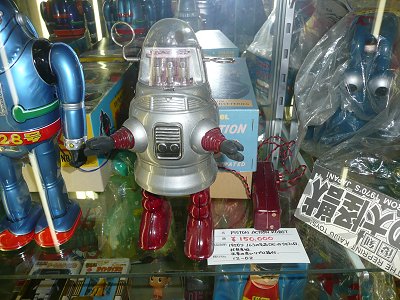
Original of the Piston Action Robot (ROBBY) at a shop
in Nakano (Tokyo, Japan) - photo by Rob van der Bijl, April 4, 2009.
Epiloque
- in Broadway, the famous mall of Nakano (Tokyo) we spotted an original
of ROBBY (April, 2009). Built in 1950 and now for sale for 150.000 yen.
ROBBY was and still is a special robot indeed!
(C)
Rob van der Bijl (RVDB's
Robotics Lab), Amsterdam NETHERLANDS, May 2008 - February 2023
|














 Strandbeest model
- photo by Rob van der Bijl, The Hague, September 21, 2015.
Strandbeest model
- photo by Rob van der Bijl, The Hague, September 21, 2015. Strandbeest model
on Orange Beach - photo by Rob van der Bijl, October 9, 2011.
Strandbeest model
on Orange Beach - photo by Rob van der Bijl, October 9, 2011.



 Image
Yonezawa compilation by Rob van der Bijl.
Image
Yonezawa compilation by Rob van der Bijl. 












